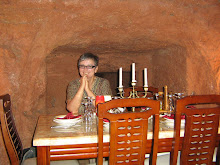

There should be something happening every day. That's one of the propositions put forward at the meeting I attended about Valletta as EU capital of culture in 2018.
That will be the easy part because it's already happening. Even the physical infrastructure is already in place and there are certainly artists producing high quality work here in Malta. What will need a lot of groundwork and imagination is community engagement in art production, not just consumption, and contemporary artwork that challenges the status quo.
I want to give a brief glimpse of what's already happening by summarising some of my cultural activities over the last couple of months. Rather than give a chronological list, I'll group according to some of the cultural venues that are currently in use in Valletta.
I have to start with the churches. Not only are they the hub of the year round programme of fiestas, exhibitions and processions, but now they also play host to lunchtime and evening concerts. Sometimes these are associated with fund-raising projects such as the restoration of the chapel of St Catherine of Italy. The model of lunchtime concerts that was adopted here with the collaboration of St James Cavalier has now been emulated by several other churches in the capital sometimes with the effect of direct competition for audiences.
The restoration of St Catherine's is now nearing completion and perhaps in the spirit of community cultural development, the programme has been reduced to Sundays only and is currently held in the Music room of St James Cavalier. For several years, their programme has raised the profile of the venue, played a major role in raising restoration funds and seeded the idea of high quality lunchtime recitals. Now other venues can capitalise on this foundation and offer their own programmes. So over the past few weeks I've attended lunchtime recitals at St Paul's Anglican Pro-Cathedral (every two weeks on a Tuesday), a beautiful evening concert by Malta's only male voice choir, Cappella Sanctae Catharinae at the Jesuit Church in Merchant Street, and next week I'll take a friend, visiting from UK, to a lunchtime recital of Baroque music at St Francis church in Republic street. Unfortunately, the two lunchtime recital venues are now competing so I have to choose which to attend.
St James Cavalier, or perhaps I should name in particular violinist Sarah Spiteri and pianist/composer/bass singer Alex Vella Gregory, play a key role in much of the cultural activity happening around Valletta. They run their own lunchtime concert series, Performers Platform, on Wednesdays in the Music Room, but also serve as a hub for information and bookings.
St James is a multi-arts venue. The brilliant restoration of the old Knights' cavalier includes several gallery spaces showing top quality work by Maltese artists and sometimes expatriate artists with links to Malta. For a while, Malta Contemporary Art found a home in the upper galleries, but for some reason they have moved out this year as I learnt when I attended the first lecture in a series called Contemporary Art in Dialogue with... organised by Dr Raphael Vella of University of Malta at St James Cavalier.
In part 2, I'll talk about the other cultural spaces in St James Cavalier and get on to the other venues around Valletta.
















































